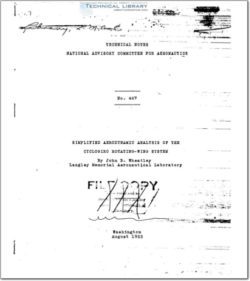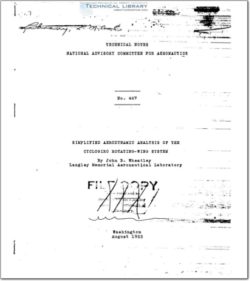naca-tn-467

- Version
- 180 Downloads
- 1.59 MB File Size
- 1 File Count
- April 23, 2016 Create Date
- April 23, 2016 Last Updated
National Advisory Committee for Aeronautics, Technical Notes - Simplified Aerodynamic Analysis of the Cyclogiro Rotating Wing System

A simplified aerodynamic theory of the cyclogiro ro-
tating wing is presented herein. In addition, examples
have been calculated showing the effect on the rotor char—
acteristics of varying the design parameters of the rotor.
A performance prediction, on the basis of the theory here.
developed. is appended. showing the performance to be ex-
pected of a machine employing this system of sustentation.
The aerodynamic principles of the cyclogiro are sound;
hovering flight, vertical climb, and a reasonable forward
speed may be obtained with a normal expenditure of power.
Autorotation in a gliding descent is available in the event
of a power—plant failure.
In carrying out a program of research on the general
problem of rotating-wing systems, the National Advisory
Committee for Aeronautics has undertaken a study of a power-
driven rotor which. because of the cycloidal path described
by the blades, is called the "cyclogiro." This rotor pos—
sesses promise in the field of hovering flight and vertical
ascent, in addition to a reasonable speed in level flight.
For the purpose of investigating the basic merit of
its aerodynamic principles, a simplified aerodynamic theory
of the cyclogiro has been-developed and is here presented.
In its present form the theory must be considered as giving
only qualitative results because of the simplifying assump—
tions found necessary in its derivation. For illustrative
purposes. the theory has been applied to a rotor of assumed
proportions. and the Variation of the rotor characteristics
with changes in the basic rotor parameters is shown in the
form of horsepower required curves.
The cyclogiro rotating-wing system is shown in figure
1. The rotor consists of several blades rotating about a
horizontal axis perpendicular to the direction of normal
flight. The angle of the individual blades to the tangent
of the circle of the blade‘s path is varied by a double—
cam arrangement so designed that the periodic oscillation
of the blades about their span axis may be changed both in
amplitude and in phase angle (fig. 2). The net force on
the rotor may thus be varied in magnitude and direction by
movements of the cams.
| File | Action |
|---|---|
| naca-tn-467 Simplified Aerodynamic Analysis of the Cyclogiro Rotating Wing System.pdf | Download |
Comment On This Post